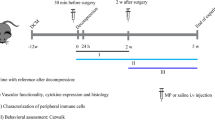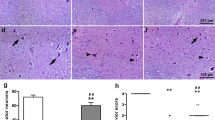Summary.
In this experimental study the efficiacy of methylprednisolone was investigated by neurophysiological and histopathological evaluation in a rabbit cauda equina model where injury was produced with an aneurysm clip (closed pressure 192 gr). High dose methylprednisolone (kg/30 mg) was administered by intravenous infusion in the 8th, 16th and 24th hours after injury followed by infusion of the same dosage every 6 hours for 24 hours. Nerve conduction velocity was measured before and early after trauma and 3 weeks after injury. Both neurophysiological and histopathological investigations demonstrated the neuroprotective effectiveness of methylprednisolone if it was given in the 8th hour after trauma. Although recovery was observed its efficiacy was less pronounced when it was given in the 16th and 24th hours.
Similar content being viewed by others
Author information
Authors and Affiliations
Additional information
Published online August 12, 2002
Rights and permissions
About this article
Cite this article
Gök, A., Uk, C., Yılmaz, M. et al. Efficiacy of Methylprednisolone in Acute Experimental Cauda Equina Injury. Acta Neurochir (Wien) 144, 817–821 (2002). https://doi.org/10.1007/s00701-002-0964-z
Issue Date:
DOI: https://doi.org/10.1007/s00701-002-0964-z




